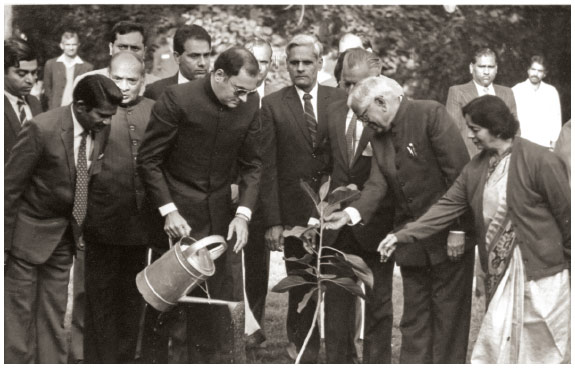About IGNCA
The Five Trees
The five trees which are most significant in Indian civilization were planted by the Late Prime Minister Shri Rajiv Gandhi. These trees are associated with the different divisions of the Centre and replanted appropriately.-
Shri Rajiv Gandhi Planting a tree at Inaugruation
 |
The Asvattha (Ficus Religiosa), popularly known as the Bodhi tree, symbolizing enlightenment after a period of introspection; the constant quest of delving into the self and human consciousness for future enlightenment, is the first principle of the Centre. It is the central conceptual pillar.The Asvattha is associated with the SUTRADHARA. |
 |
The Nyagrodha (Ficus Bengalensis), a tree which grows to large proportions, the basis of the metaphysical metaphor of the upside down tree with branches which grow roots and roots which grow as branches. This interplay of the past and the present, rejuvenation and renewal, allowing for fluidity within periphery of a circle with a still Centre, is the second principle.
The Nyagrodha is associated with the landscaping of JANAPADA SAMPADA . |
 |
The Asoka (Saraca Indica), an ancient tree from which the name of the great emperor Asoka was derived, means, without grief. The tree and the name have provided some of the most fundamental motifs to Indian art. Representing fertility, it pervades the classical and medieval arts. It is as important in the biological sciences as it is in metaphysics and the artistic traditions. The tree symbolises the interdisciplinary approach, the third fundamental principle of the centre.
The Asoka is associated with KALANIDHI . |
 |
The Arjuna (Terminalia), the tree represents clarity and purity, erectness and direction. Intellectual rigor, incisiveness and integrity, become the fourth principle of the Centre. Through its long range reference work programmes it is hoped that a clearer and more balanced view of the Indian arts will be evident.
The Arjuna is associated with KALAKOSA. |
 |
The Kadamba (Anthocephalus cadamba), the fragrant flower tree representing joy, mirth, play, dance and music. The essence of creativity with its bliss and joy, its fragrance and its upliftment make the fifth principle.
The Kadamba is associated with KALADARSANA |





